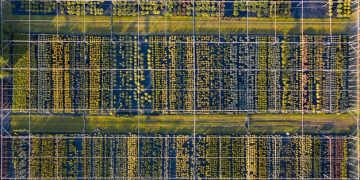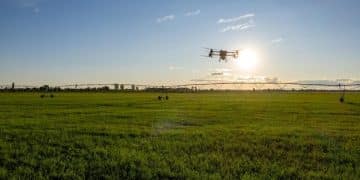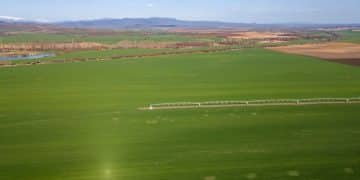Automated Irrigation: Save Water & Boost Your Farm’s Health
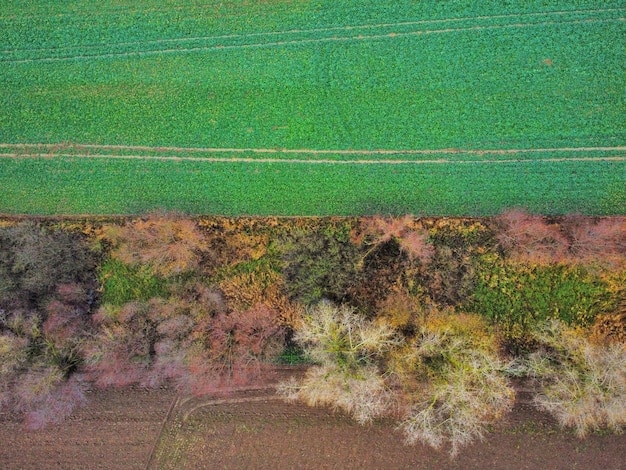
Automated irrigation systems offer a solution to conserve water by up to 30% and improve crop health through precise water management, optimizing resource use and enhancing agricultural productivity.
Discover how automated irrigation systems: Save 30% on water usage and boost crop health for farms of all sizes. These systems use sensors and smart technology to deliver water only when and where it’s needed, which saves you money and reduces environmental impact.
Understanding Automated Irrigation Systems
Automated irrigation systems are revolutionizing the way we approach agriculture by providing precise and efficient water management. These systems help farmers optimize water usage, reduce waste, and improve crop health. This leads to increased yields and significant cost savings.
By understanding how these systems work and the benefits they offer, growers can make informed decisions about adopting this technology on their farms. The goal is to enhance productivity and sustainability.
Components of Automated Irrigation Systems
An automated irrigation system consists of several key components that work together to ensure efficient water delivery. These components include sensors, controllers, valves, and emitters. Each plays a crucial role in the overall functionality of the system.
These components ensure that crops receive the right amount of water at the right time, optimizing growth and minimizing waste.
- Sensors: Monitor soil moisture and weather conditions to determine when irrigation is needed.
- Controllers: Act as the brains of the system, interpreting data from sensors and adjusting irrigation schedules accordingly.
- Valves: Control the flow of water to different sections of the field based on the controller’s instructions.
- Emitters: Deliver water directly to the plants, using methods like drip irrigation or micro-sprinklers.

In summary, understanding the individual components and how they interact is essential for implementing and maintaining an efficient automated irrigation system. These systems offer a means of achieving optimal water usage for crops.
The Benefits of Automation: Saving Water and Enhancing Crop Health
Automated irrigation systems offer benefits that extend beyond water conservation. They also play a key role in enhancing crop health and productivity. By delivering water precisely when and where it’s needed, these systems can help prevent overwatering and underwatering.
This results in healthier plants, improved yields, and reduced risk of disease.
Water Conservation
One of the primary benefits of automated irrigation systems is their ability to conserve water. Traditional irrigation methods often result in significant water waste due to evaporation, runoff, and uneven distribution. Automated systems minimize these losses by delivering water directly to the plant’s root zone.
As a result, automated irrigation systems: Save 30% on water usage and boost crop health.
- Reduced Evaporation: Drip irrigation and micro-sprinklers minimize water exposure to the air, reducing evaporation.
- Precise Application: Water is delivered directly to the plant’s roots, ensuring efficient uptake.
- Scheduled Irrigation: Systems can be programmed to irrigate during optimal times to reduce water loss.
Improved Crop Health
Optimal soil moisture levels are crucial for plant health. Automated irrigation systems help maintain these levels by continuously monitoring soil conditions and adjusting watering schedules accordingly.
This leads to healthier plants, stronger root systems, and increased resistance to pests and diseases.
- Consistent Moisture Levels: Prevents stress caused by over or under watering.
- Nutrient Uptake: Facilitates efficient absorption of nutrients from the soil.
- Reduced Disease Risk: Minimizes leaf wetness, which can promote fungal growth.
By conserving water and improving crop health, automated irrigation systems offer a sustainable and cost-effective solution for modern agriculture. These systems benefit both the environment and the farmer’s bottom line.
Types of Automated Irrigation Systems
There are several types of automated irrigation systems available, each designed to meet the specific needs of different crops and farming environments. The most common types include drip irrigation, sprinkler systems, and subsurface drip irrigation. Understanding the features and benefits of each system is essential.
Selecting the appropriate system can maximize water savings and crop yields.
Drip Irrigation
Drip irrigation delivers water directly to the root zone of plants through a network of tubes and emitters. This method minimizes water loss due to evaporation and runoff. It is ideal for row crops, orchards, and vineyards.
Drip irrigation can be installed above or below ground, depending on the crop type and soil conditions.
Sprinkler Systems
Sprinkler systems distribute water over the entire field using overhead sprinklers. This method is suitable for a wide range of crops and can be adapted to different field sizes and shapes. Sprinkler systems can be automated using timers and sensors to optimize water usage.
Sprinkler systems work well for lawns, pastures, and some vegetable crops.
Subsurface Drip Irrigation (SDI)
Subsurface drip irrigation involves burying drip lines below the soil surface. This method further reduces water loss due to evaporation and runoff and can help minimize weed growth. SDI is particularly effective for long-term crops and in areas with limited water resources.
SDI is often used for crops like alfalfa, corn, and cotton.
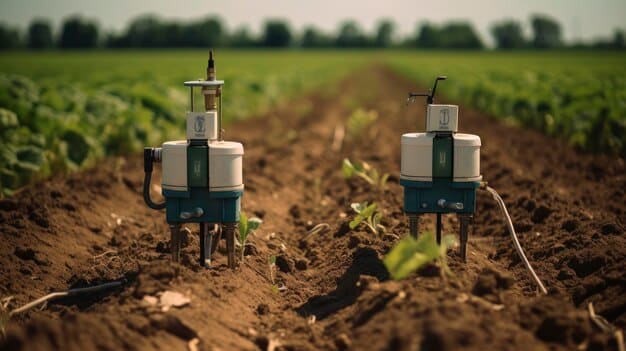
Choosing the right automated irrigation system depends on several factors, including crop type, climate, soil conditions, and budget. Farmers should carefully evaluate their needs and consult with irrigation specialists to determine the most suitable solution. These systems enhance crop yield and save water.
Implementing Automated Irrigation: A Step-by-Step Guide
Implementing an automated irrigation system involves careful planning and execution. The process typically includes assessing your irrigation needs, selecting the right system, designing the layout, installing the components, and programming the controller. Each of these steps is crucial for ensuring the system operates efficiently and effectively.
Attention to detail ensures optimal performance and long-term cost savings.
Assessing Irrigation Needs
Before installing an automated irrigation system, it’s important to evaluate your farm’s unique irrigation needs. This involves considering factors such as soil type, crop water requirements, climate conditions, and available water resources. Soil testing and historical weather data can provide valuable insight into these factors.
This step ensures that the system is tailored to your specific needs.
System Selection and Design
Based on your irrigation needs, the next step is to select the type of automated system that is best suited for your farm. This involves considering factors such as cost, efficiency, ease of use, and maintenance requirements. A well-designed system layout is essential for ensuring uniform water distribution and optimal crop performance.
Proper design maximizes the benefits of the automated system.
Installation and Programming
The installation process involves laying out the irrigation lines, installing emitters, connecting the controller, and setting up the sensors. Programming the controller involves setting irrigation schedules based on sensor data and crop water requirements. This step requires careful attention to detail.
A correctly programmed system delivers water efficiently and effectively.
- Install sensors at representative locations in the field.
- Connect all components according to the manufacturer’s instructions.
- Test the system to ensure uniform water distribution.
By following these steps, farmers can successfully implement an automated irrigation system and realize the numerous benefits it offers. These systems enhance productivity and sustainability in farming operations.
Maintenance and Troubleshooting
Like any mechanical system, automated irrigation systems require regular maintenance to ensure optimal performance. Preventative maintenance can help prolong the life of your system. Proper maintenance can prevent problems.
Proper maintenance can also minimize downtime and maximize water savings.
Regular Maintenance Tasks
Regular maintenance tasks for automated irrigation systems include checking for leaks, cleaning emitters, inspecting sensors, and verifying controller settings. It’s also important to flush the system periodically to remove sediment and debris. Performing these tasks ensures that the system operates.
Well-maintained systems operate efficiently and reliably.
Troubleshooting Common Issues
Despite regular maintenance, automated irrigation systems may experience occasional problems. Common issues include clogged emitters, sensor malfunctions, controller programming errors, and leaks. Troubleshooting these issues. Quickly addressing these issues will minimize downtime and loss.
Prompt troubleshooting ensures irrigation systems function optimally.
- Check emitters for blockages and clean.
- Verify that sensors are properly calibrated and functioning.
- Review controller settings to ensure programmed correctly.
By implementing a proactive maintenance program and addressing issues promptly, farmers can extend the lifespan of their automated irrigation systems and maximize their return on investment. These systems promote sustainability in agricultural practices.
Future Trends in Automated Irrigation
The field of automated irrigation is constantly evolving, with new technologies and innovations emerging regularly. These advancements offer the potential to further improve water efficiency, enhance crop health, and reduce labor costs. Staying informed about these future trends allows farmers.
Staying informed enables farmers to make strategic decisions.
Smart Sensors and IoT
One of the most promising trends in automated irrigation is the integration of smart sensors and Internet of Things (IoT) technology. These sensors provide real-time data on soil moisture, weather conditions, and plant health. This data is used to optimize irrigation schedules and improve decision-making.
Smart sensors enable precision irrigation.
AI and Machine Learning
Artificial intelligence (AI) and machine learning are also playing a growing role in automated irrigation systems. AI algorithms analyze data from sensors to predict crop water requirements. The result is the ability to automatically adjust irrigation schedules and ensure optimal water usage.
AI and Machine Learning enhance resource efficiency.
- Real-time monitoring of soil conditions.
- Remote management of irrigation systems.
- Data driven insights for decision making.
As these technologies continue to advance, automated irrigation systems will become even more efficient, reliable, and sustainable. This offers benefits to both farmers and the environment.
| Key Point | Brief Description |
|---|---|
| 💧 Water Savings | Reduces water usage by up to 30% through precise application. |
| 🌱 Crop Health | Maintains optimal moisture levels for healthier plants and increased yields. |
| ⚙️ Automation | Uses sensors, controllers, and valves to deliver water efficiently. |
| 📊 Future Trends | Integrates smart sensors, IoT, AI, and machine learning for enhanced efficiency. |
Frequently Asked Questions
Automated irrigation systems can reduce water usage by up to 30% compared to traditional irrigation methods. The extent of savings depends on the specific system, crop type, and local climate conditions.
Automated irrigation systems are versatile and suitable for a wide range of crops, including row crops like corn and soybeans, orchards with fruit trees, vineyards with grapes, and vegetable crops such as tomatoes and peppers.
Regular maintenance should be performed at least once a month during the growing season. This includes checking for leaks, cleaning emitters, inspecting sensors, and verifying controller settings to ensure optimal performance.
The lifespan of an automated irrigation system can range from 10 to 20 years, depending on the quality of the components, the climate, and the level of maintenance. Proper care and regular inspections can extend the system’s lifespan.
To troubleshoot clogged emitters, start by flushing the system to remove sediment and debris. You can also use a small brush or needle to clear individual emitters. Installing a filter at the water source can prevent future clogs.
Conclusion
Adopting automated irrigation systems represents a pivotal step towards sustainable and efficient agriculture. By embracing these technologies, farmers can significantly reduce water consumption, boost crop yields, and contribute to a more sustainable future for farming.
